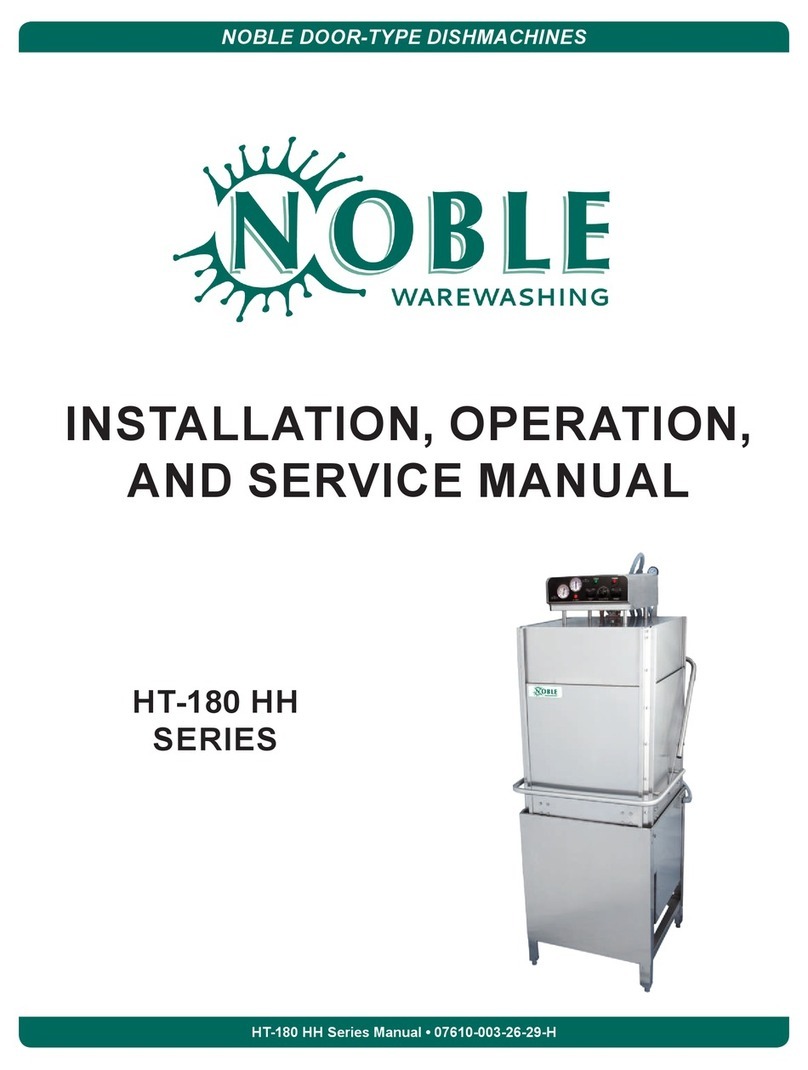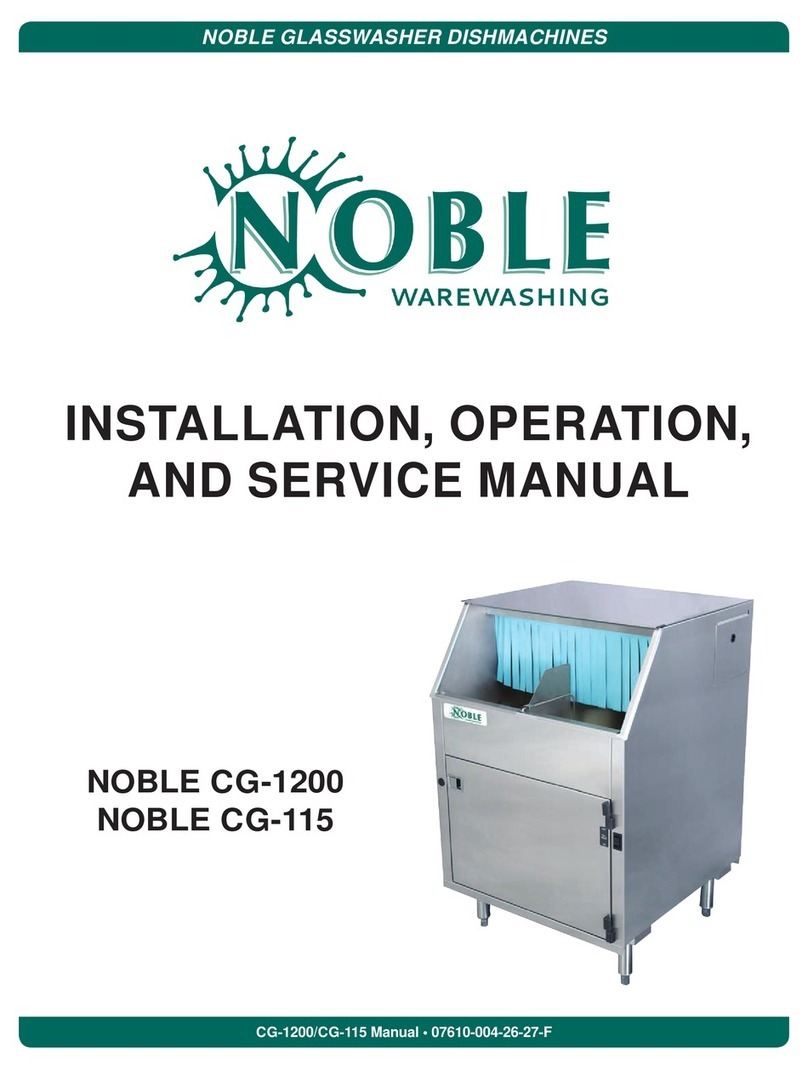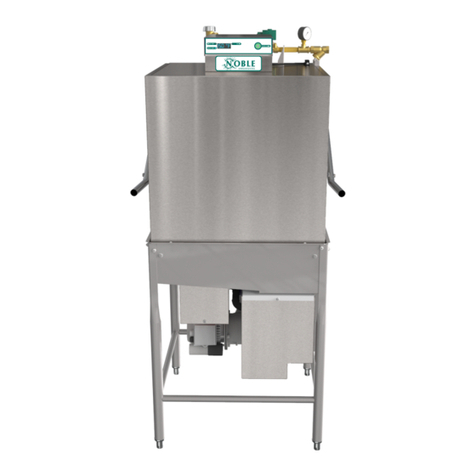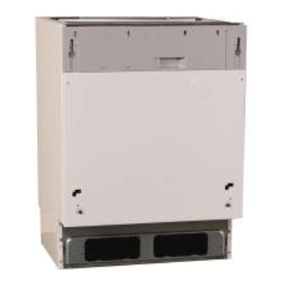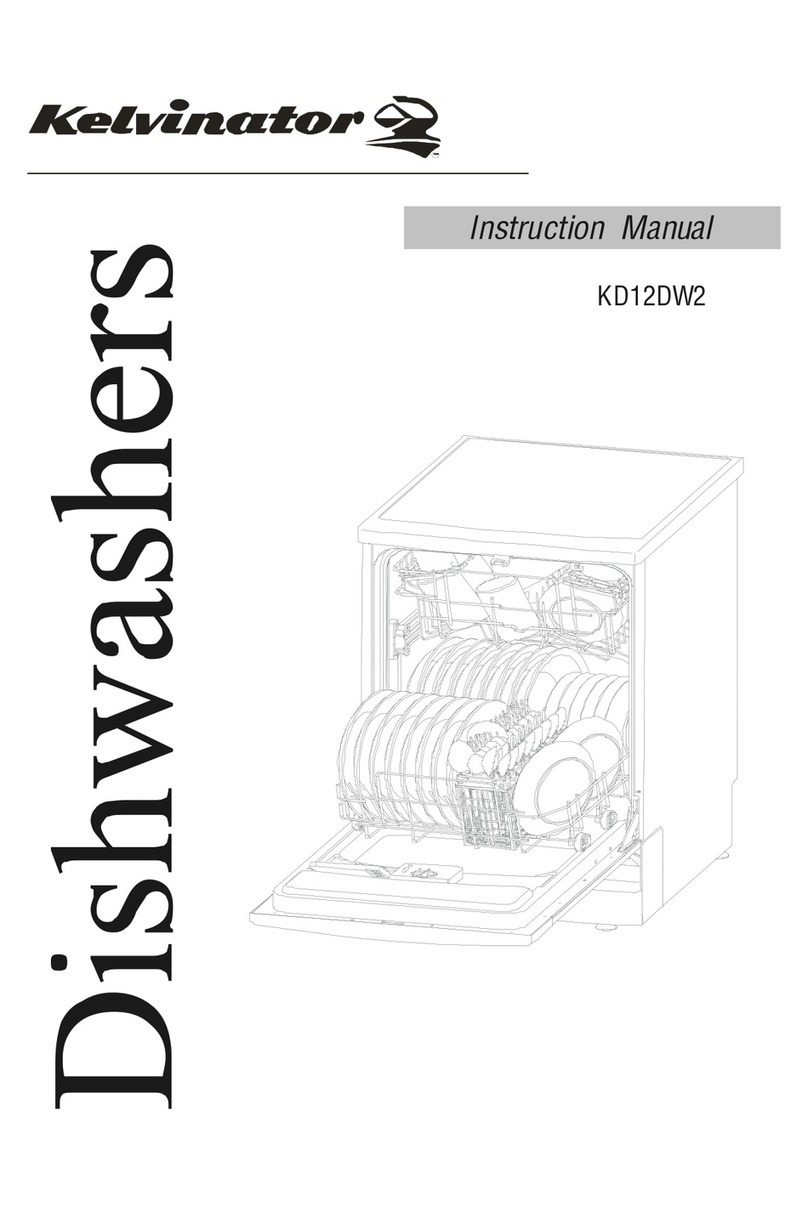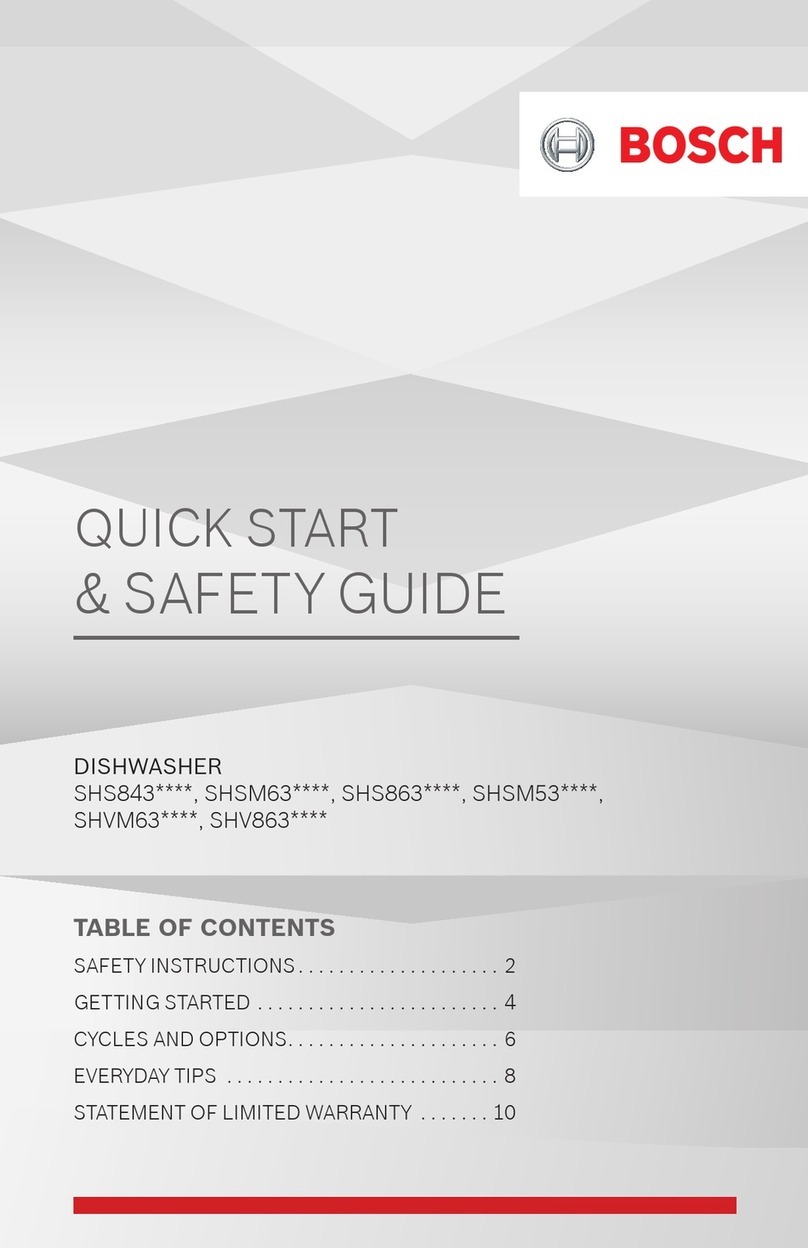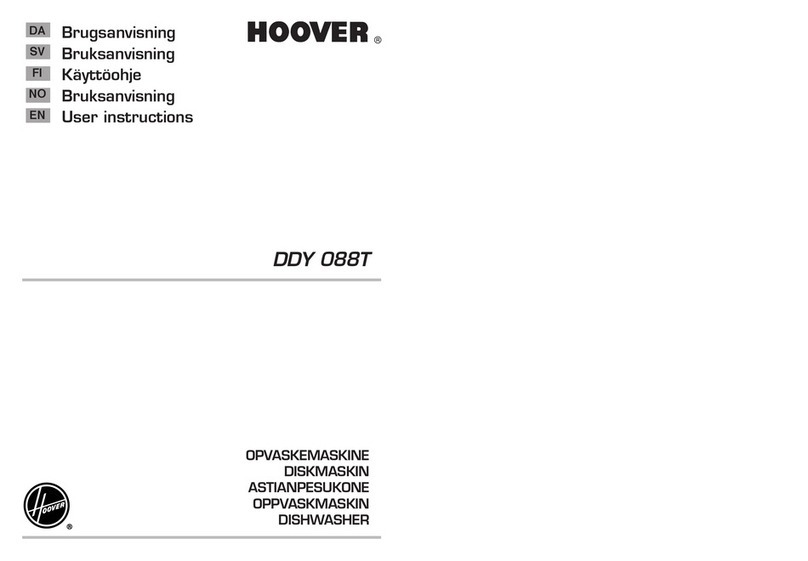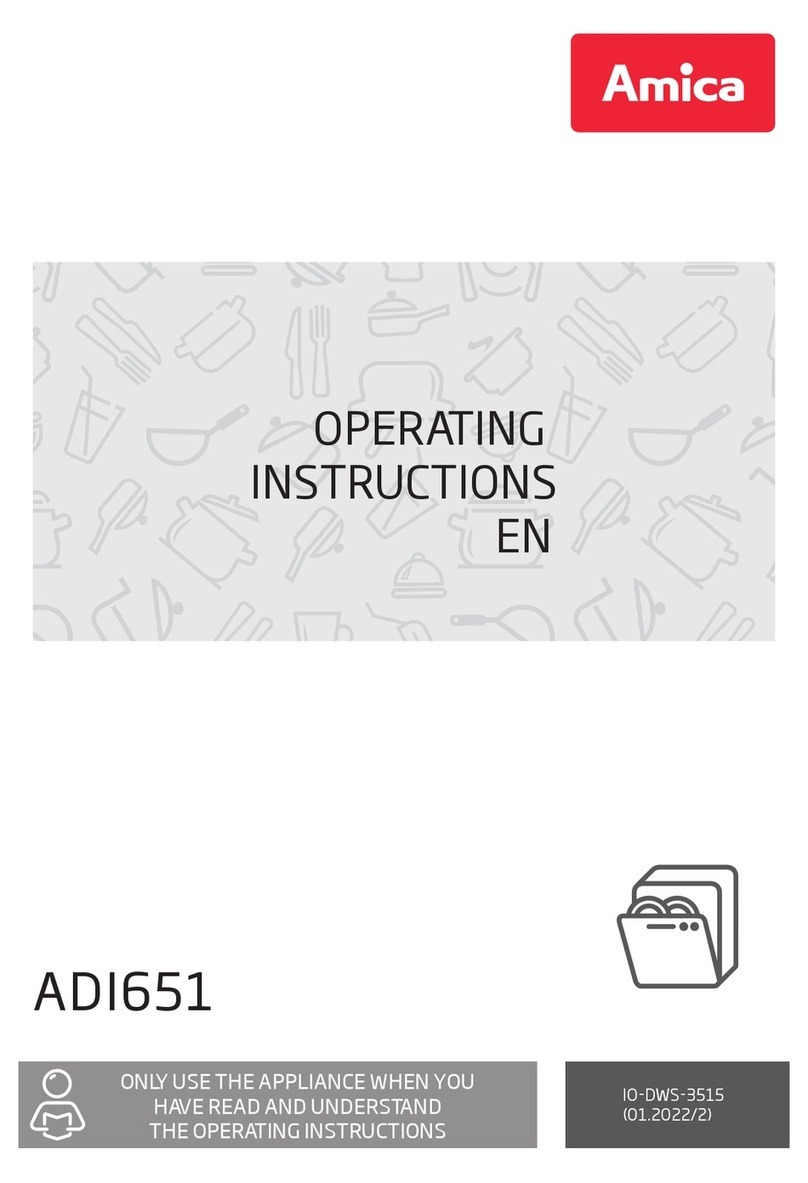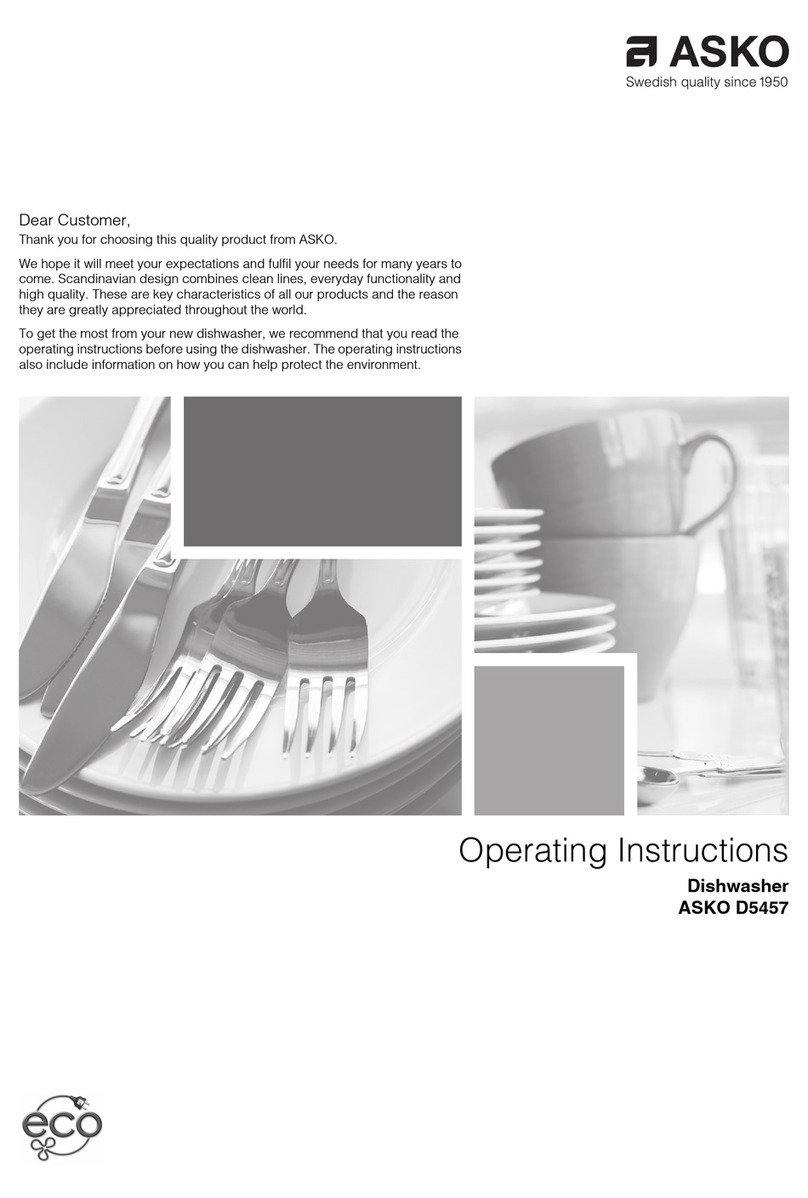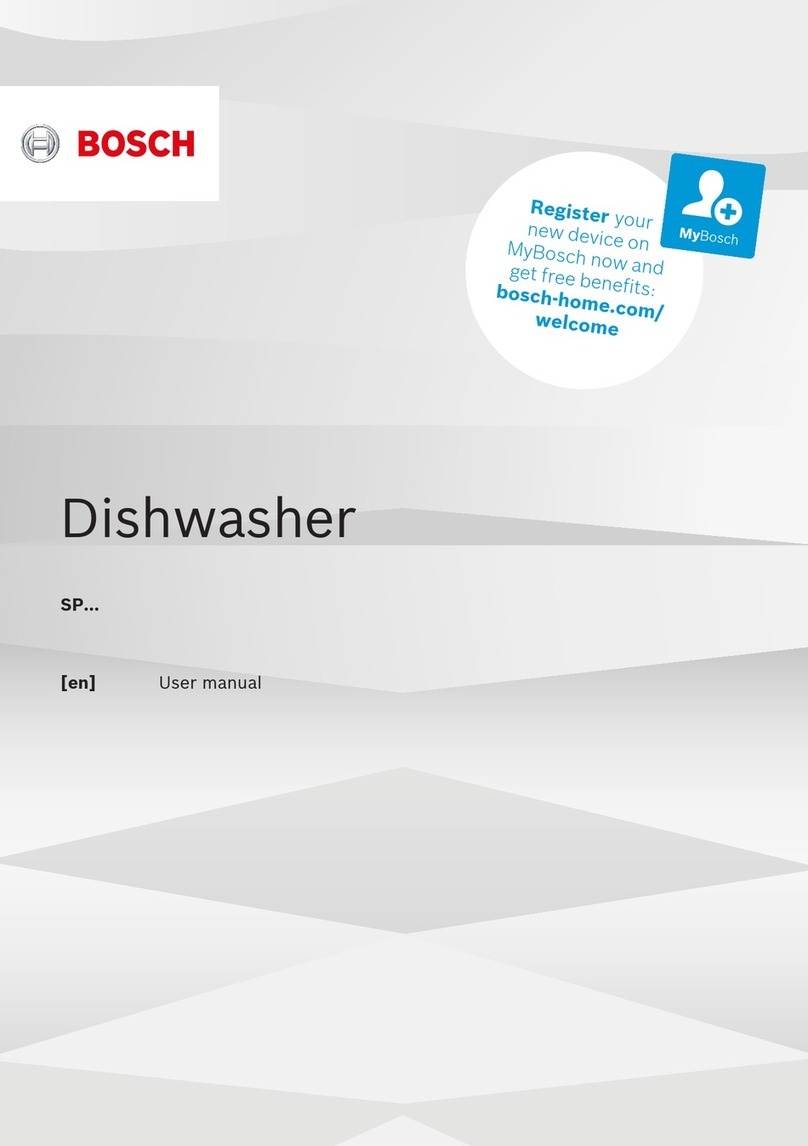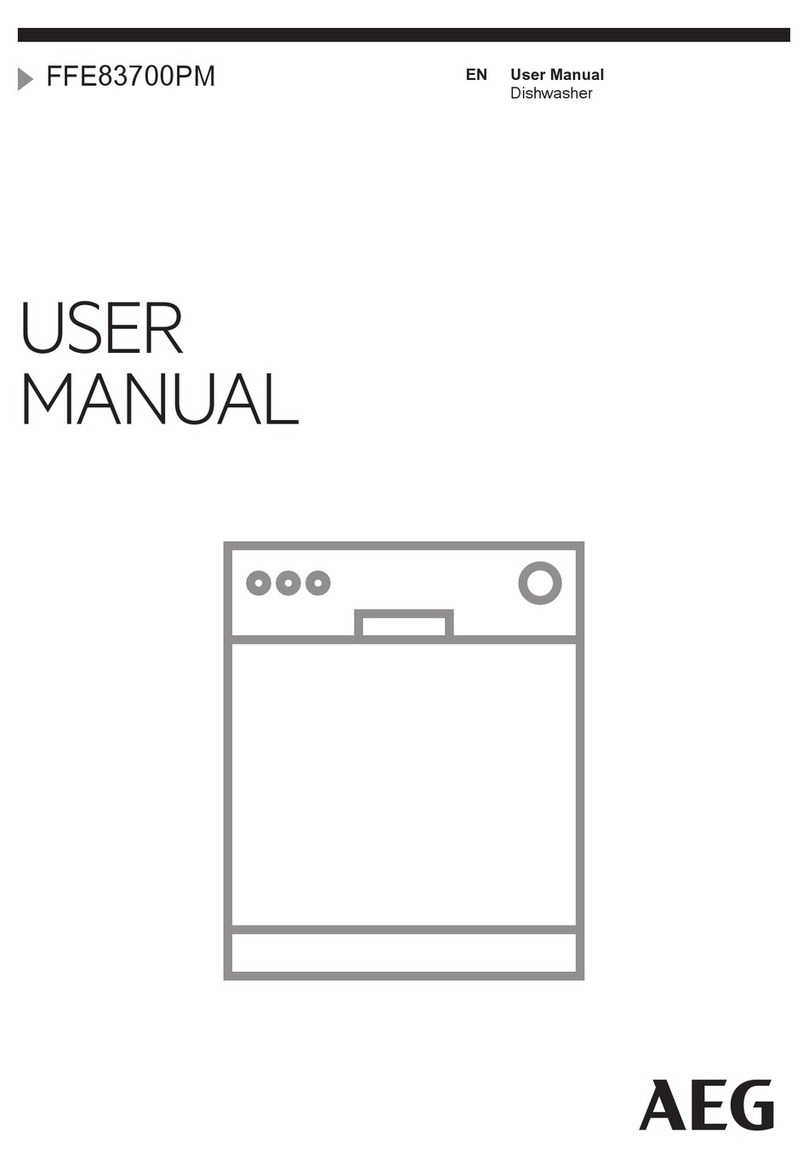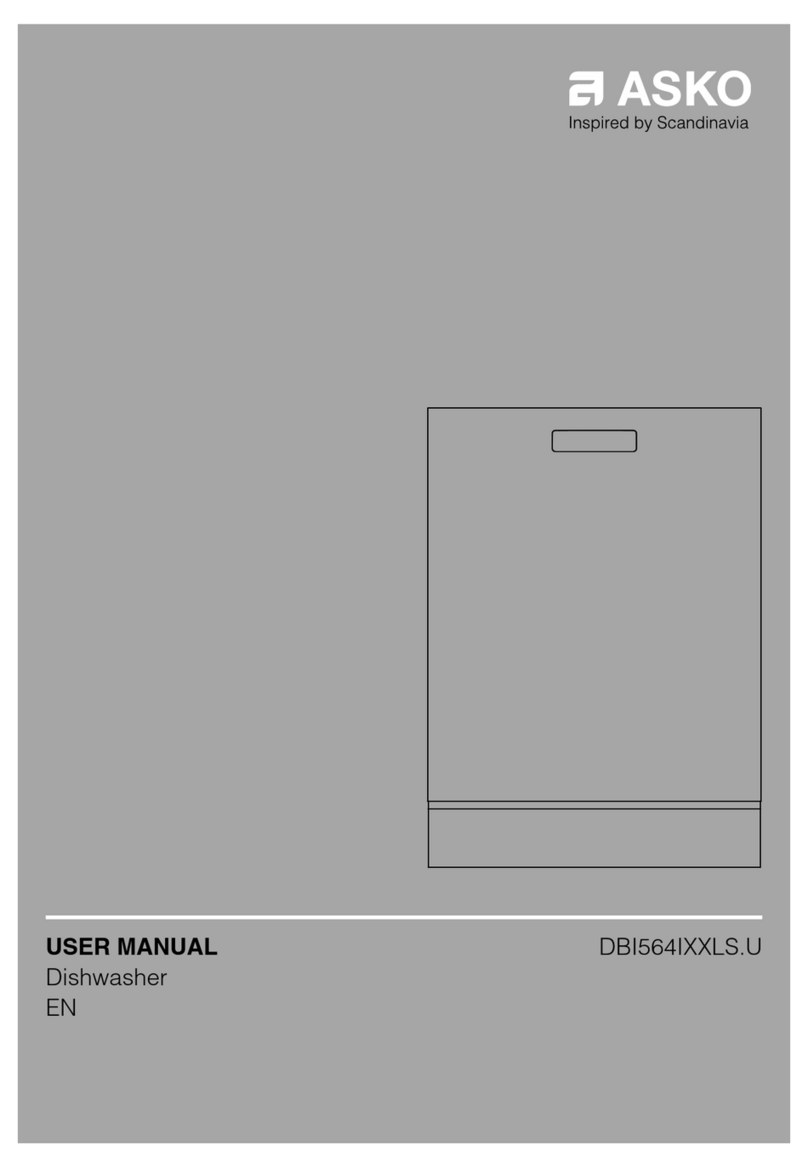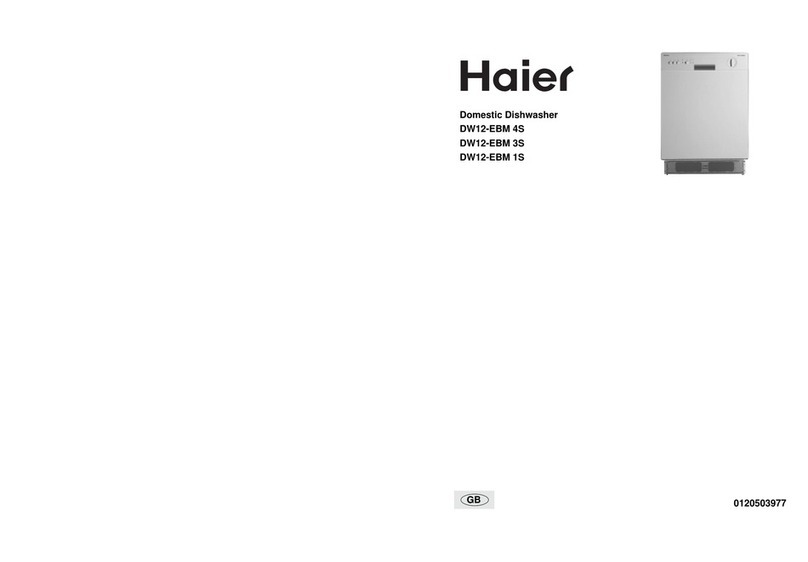Noble HT-180 Series User manual

INSTALLATION/OPERATION
& TECHNICAL MANUAL
ELECTRICALLY HEATED MODELS:
NOBLE HT-180
NOBLE HT-180
with Ventless and Energy Recovery
NOBLE HT-180 SERIES UPRIGHT DOOR DISHMACHINES
July 16, 2015
P/N 07610-004-25-05
Noble Warewashing
Lancaster, Pennsylvania
www.nobleproducts.biz


iii
REVISION REVISION
DATE
MADE
BY
APPLICABLE
ECN DETAILS
A 07-16-15 KAP Process Released to production.

iv
NOMENCLATURE FOR THE MODELS COVERED IN THIS MANUAL
Model:
Serial No.:
Installation Date:
Service Rep. Name:
Phone No.:
NOBLE HT-180
Electrically heated, high temp, hot water sanitizing, with booster heater,
doortype dishmachine
NOBLE HT-180 with Ventless and Energy Recovery
Electrically heated, high temp, hot water sanitizing, with booster heater
doortype dishmachine and ventless heat recovery system

Section Description Page
I. Specifications
Operating Capacities 2
Electrical Requirements 3
Dimensions 4
Table Dimensions 5
II. Installation/Operation Instructions
Installation Instructions 8
Electrical Installation Instructions 9
Operation Instructions 10
Detergent Control 11
False Panel Installation 12
III. Preventative Maintenance 14
IV. Troubleshooting Section 16
V. Drawing/Parts Section
Top Mounted Control Box Assembly (Universal Timer) 19
Hood Assembly (Bolted Single Support Design) 21
Cantilever Arm/Door Assemblies 22
Tub Assembly 24
Frame Assembly 26
Rinse Tank Assembly 27
Wash Motors 39
Motor & Pump Assembly 30
Wash Heaters/Rinse Heaters 31
Incoming Plumbing/Outlet Plumbing Assembly 33
WPRK Kit Option 34
NOBLE HT-180 Incoming Plumbing Assemblies 35
NOBLE HT-180 - Ventless Plumbing Assemblies 36
1/2” Solenoid Valve & 1/2” NPT Vacuum Breaker Repair Parts Kits 38
Wash and Rinse Arm/Manifold Assemblies 39
NOBLE HT-180 - Ventless Heat Recovery Assembly 41
NOBLE HT-180 - Ventless Door Interlock 43
Door Interlock/Exhaust Fan Control/Transformer Mounting Box Components 44
False Panel Installation 45
GO*BOX Kit 46
Drain Quench Assembly 47
TABLE OF CONTENTS
v

VI.A Electrical Diagrams - Top Mounted Control Boxes
Solid State 208 - 230V, 50/60 Hz, single/three phase 49
Noble HT-180 (UT w/Cycle Switches) 208 - 230V, 50/60 Hz, single/three phase 50
Solid State 460V, 60 Hz, three phase 51
Noble HT-180 (UT w/Cycle Switches) 460V, 60 Hz, three phase 52
Noble HT-180 (UT w/Cycle Switches) 208 - 230V, 50/60 Hz, single/three phase 53
Noble HT-180 (UT w/Cycle Switches) 460V, 60 Hz, three phase 54
Noble HT-180 (Universal Timer) 208 - 230V, 60 Hz, single/three phase 55
VI.C Electrical Diagram Options
Door Interlock 57
Drain Quench 57
Exhaust Fan Control 58
TABLE OF CONTENTS
vi

1
SECTION 1:
SPECIFICATION INFORMATION

SECTION 1: SPECIFICATION INFORMATION
OPERATING CAPACITIES
PERFORMANCE/CAPABILITIES
OPERATING CAPACITY:
(NOBLE HT-180)
RACKS PER HOUR 58
DISHES PER HOUR 1450
GLASSES PER HOUR 2088
(NOBLE HT-180-VENTLESS)
RACKS PER HOUR 39
DISHES PER HOUR 975
GLASSES PER HOUR 1404
OPERATING CYCLE (SECONDS):
MINIMUM (OTHER CYCLE TIMES ARE AVAILABLE)
(NOBLE HT-180)
WASH TIME 40
RINSE TIME 13
DWELL TIME 4
TOTAL CYCLE TIME 57
(NOBLE HT-180-VENTLESS)
WASH TIME 40
RINSE TIME 13
DWELL TIME 4
CONDENSATE REMOVAL 30
TOTAL CYCLE TIME 87
TANK CAPACITY:
WASH TANK (GAL) 8.0
WASH TANK (L) 30.3
RINSE TANK (TEMPSTAR) (GAL) 3.0
RINSE TANK (TEMPSTAR) (L) 11.4
ELECTRICAL REQUIREMENTS
WASH MOTOR HP 3/4
NOTE: Always refer to the machine data plate for specific
electrical and water requirements. The material provided
on this page is for reference only and may be subject to
change without notice.
WATER REQUIREMENTS
NOBLE HT-180:
WASH TEMPERATURE (MINIMUM)(°F) 150
WASH TEMPERATURE (MINIMUM)(°C) 66
RINSE TEMPERATURE (MINIMUM)(°F) 180
RINSE TEMPERATURE (MINIMUM)(°C) 83
INLET WATER TEMPERATURE:
12KW RINSE HEATER (°F) 140
12KW RINSE HEATER (°C) 60
14KW RINSE HEATER (°F) 110
14KW RINSE HEATER (°C) 44
14KW VENTLESS (°F) 40-70
14KW VENTLESS (°C) 4.4-21
FLOW PRESSURE (PSI) 10
WATER LINE SIZE (NPT) (VENTED) 1/2”
WATER LINE SZE (VENTLESS) 3/4"
DRAIN LINE SIZE (NPT) 1 1/2”
FLOW PRESSURE (PSI) 10
WATER LINE SIZE (NPT) 1/2”
DRAIN LINE SIZE (NPT) 1 1/2”
2

SECTION 1: SPECIFICATION INFORMATION
ELECTRICAL REQUIREMENTS
3
NOBLE HT-180:
RINSE TYPICAL
HEATER TOTAL ELECTRICAL
VOLTS PH HZ RATINGS AMPS CIRCUIT
208 1 50 12KW@240V 71 A 90 AMP
208 1 50 14KW@240V 78 A 100 AMP
230 1 50 12KW@240V 78 A 100 AMP
230 1 50 14KW@240V 86 A 110 AMP
208 3 50 12KW@240V 45 A 60 AMP
208 3 50 14KW@240V 49 A 70 AMP
230 3 50 12KW@240V 48 A 60 AMP
230 3 50 14KW@240V 53 A 70 AMP
380 3 50 12KW@380V 29 A 40 AMP
380* 3 50 14KW@208V 34 A 45 AMP
415 3 50 12KW@415V 26 A 35 AMP
415 3 50 14KW@415V 29 A 40 AMP
440 3 50 12KW@460V 21 A 30 AMP
440 3 50 14KW@460V 25 A 35 AMP
208 1 60 12KW@240V 69 A 90 AMP
208 1 60 14KW@240V 76 A 100 AMP
230 1 60 12KW@240V 76 A 100AMP
230 1 60 14KW@240V 84 A 110 AMP
208 3 60 12KW@240V 43 A 60 AMP
208 3 60 14KW@240V 47 A 60 AMP
230 3 60 12KW@240V 46 A 60 AMP
230 3 60 14KW@240V 51 A 70 AMP
460 3 60 12KW@480V 22 A 30 AMP
460 3 60 14KW@480V 25 A 35 AMP
* This model is wired in a wye configuration for the heaters.
NOTE: Typical Electrical Circuit is based upon (1) 125% of the full amperage load of the machine and (2) typical
fixed-trip circuit breaker sizes as listed in the NEC 2002 Edition. Local codes may require more stringent protection
than what is displayed here. Always verify with your electrical service contractor that your circuit protection is ade-
quate and meets all applicable national and local codes. These numbers are provided in this manual simply for ref-
erence and may change without notice at any given time.

SECTION 1: SPECIFICATION INFORMATION
DIMENSIONS NOBLE HT-180 (TOP MOUNTED CONTROL BOX)
4
25 1/4” (64.1 cm)
32” (81.3 cm)
17 1/2”
(44.5 cm)
MACHINE
OPENING
34” (86.4 cm)
TABLE
HEIGHT
76” (193 cm)
W/ DOOR OPEN
14”
(35.6 cm)
DRAIN
TO
FLOOR
64 3/8”
(163.5 cm)
60 5/8”
(154 cm)
61 3/4”
(156.8 cm)
WATER
INLET TO
FLOOR
A- WATER INLET (1/2” NPT)
B- ELECTRICAL CONNECTION POINT
C- DRAIN (1 1/2” NPT)
D- STANDARD CLEARANCE BETWEEN
MACHINE AND WALL (WITH DISHTABLE) IS 4” (10.2 cm).
D
A
B
B
D
C
15 1/2” (39.4 cm)
LEGEND
4 7/8” (12.4 cm)

SECTION 1: SPECIFICATION INFORMATION
DIMENSIONS NOBLE HT-180 - VENTLESS (TOP MOUNTED CONTROL BOX)
5

SECTION 1: SPECIFICATION INFORMATION
TABLE DIMENSIONS
6
TABLE DIMENSIONS
CORNER INSTALLATION
TABLE DIMENSIONS
CONNECTION TO DISHMACHINE
TABLE DIMENSIONS
STRAIGHT THROUGH INSTALLATION
20 1/2” (52.1 cm)
OPENING
25 1/4”
(64.1 cm)
2 1/2” (6.4 cm)
4” (10.2 cm)
MINIMUM
2 1/2”
(6.4 cm)
4” (10.2 cm)
MINIMUM
20 1/2” (52.1 cm)
OPENING
25 1/4”
(64.1 cm)
20 1/2” (52.1 cm)
3/4” (1.9 cm)
1 1/2” (3.81 cm) ROLL
4” (10.2 cm)
MINIMUM
2 1/2”
(6.4 cm)
25 1/4”
(64.1 cm)
20 1/2” (52.1 cm)
OPENING
25 1/4” (64.1 cm)

7
SECTION 2:
INSTALLATION/OPERATION
INSTRUCTIONS

SECTION 2: INSTALLATION/OPERATION INSTRUCTIONS
INSTALLATION INSTRUCTIONS
8
VISUAL INSPECTION: Before installing the unit, check the container and machine for damage. A damaged container is an indi-
cator that there may be some damage to the machine. If there is damage to both the container and machine, do not throw away
the container. The dishmachine has been inspected and packed at the factory and is expected to arrive to you in new, undamaged
condition. However, rough handling by carriers or others may result in there being damage to the unit while in transit. If such a sit-
uation occurs, do not return the unit to the manufacturer; instead, contact the carrier and ask them to send a representative to the
site to inspect the damage to the unit and to complete an inspection report. You must contact the carrier within 48 hours of receiv-
ing the machine. Also, contact the dealer through which you purchased the unit.
UNPACKING THE DISHMACHINE: Once the machine has been removed from the container, ensure that there are no missing
parts from the machine. This may not be obvious at first. If it is discovered that an item is missing, contact Noble Warewashing
immediately to have the missing item shipped to you.
LEVEL THE DISHMACHINE: The dishmachine is designed to operate while being level. This is
important to prevent any damage to the machine during operation and to ensure the best results
when washing ware. The unit comes with adjustable bullet feet, which can be turned using a pair of
channel locks or by hand if the unit can be raised safely. Ensure that the unit is level from side to
side and from front to back before making any connections.
PLUMBING THE DISHMACHINE: All plumbing connections must comply with all applicable local, state, and national plumbing
codes. The plumber is responsible for ensuring that the incoming water line is thoroughly flushed prior to connecting it to any com-
ponent of the dishmachine. It is necessary to remove all foreign debris from the water line that may potentially get trapped in the
valves or cause an obstruction. Any valves that are fouled as a result of foreign matter left in the water line, and any expenses
resulting from this fouling, are not the responsibility of the manufacturer.
CONNECTING THE DRAIN LINE: The drain for the Noble models covered in this manual are gravity discharge drains. All piping
from the 1 1/2” FNPT connection on the wash tank must be pitched (1/4” per foot) to the floor or sink drain. All piping from the
machine to the drain must be a minimum 1 1/2” I.P.S. and shall not be reduced. There must also be an air gap between the machine
drain line and the floor sink or drain. If a grease trap is required by code, it should have
a flow capacity of 5 gallons per minute.
WATER SUPPLY CONNECTION: Ensure that you have read the section entitled
“PLUMBING THE DISHMACHINE” above before proceeding. Install the water supply
line (1/2” pipe size minimum) (3/4 pipe for ventless) to the dishmachine line strainer
using copper pipe. It is recommended that a water shut-off valve be installed in the
water line between the main supply and the machine to allow access for service.
The water supply line is to be capable of 10 PSI “flow” pressure at the recommended
temperature indicated on the data plate.
In areas where the water pressure fluctuates or is greater than the recommended pres-
sure, it is suggested that a water pressure regulator be installed. The Noble models
covered in this manual come with water pressure regulators as standard equipment.
Please notify Noble Warewashing immediately if this component is not present on your
machine.
Do not confuse static pressure with flow pressure. Static pressure is the line pressure in a “no flow” condition (all valves and ser-
vices are closed). Flow pressure is the pressure in the fill line when the fill valve is opened during the cycle.
It is also recommended that a shock absorber (not supplied with the Noble HT-180 model) be installed in the incoming water line.
This prevents line hammer (hydraulic shock), induced by the solenoid valve as it operates, from causing damage to the equipment.
PLUMBING CHECK: Slowly turn on the water supply to the machine after the incoming fill line and the drain line have been
installed. Check for any leaks and repair as required. All leaks must be repaired prior to placing the machine in operation.
ELECTRICAL POWER CONNECTION: Electrical and grounding connections must comply with the applicable portions of the
National Electrical Code ANSI/NFPA 70 (latest edition) and/or other electrical codes.
Disconnect electrical power supply and place a tag at the disconnect switch to indicate that you are working on the circuit.
The dishmachine data plate is located on the right side and to the front of the machine. Refer to the data plate for machine oper-
Frame with Adjustable Foot
Raise Lower
Incoming Plumbing Y-strainer Connection

ating requirements, machine voltage, total amperage load and serial number.
To install the incoming power lines, open the control box. This will require taking a phillipshead screwdriver and removing the four
(4) screws on the front cover of the control box. Install 3/4” conduit into the pre-punched holes in the back of the control box. Route
power wires and connect to power block and grounding lug. Install the service wires (L1, L2, and L3 (3 phase only)) to the appro-
priate terminals as they are marked on the terminal block. Install the grounding wire
into the lug provided. Tighten the connections. It is recommended that “DE-OX” or
another similar anti-oxidation agent be used on all power connections.
VOLTAGE CHECK: Ensure that the power switch is in the OFF position and
apply power to the dishmachine. Check the incoming power at the terminal block
and ensure it corresponds to the voltage listed on the data plate. If not, contact a
qualified service agency to examine the problem. Do not run the dishmachine if
the voltage is too high or too low. Shut off the service breaker and mark it as
being for the dishmachine. Advise all proper personnel of any problems and of
the location of the service breaker. Replace the control box cover and tighten
down the screws.
SECTION 2: INSTALLATION/OPERATION INSTRUCTIONS
INSTALLATION INSTRUCTIONS (CONTINUED)
9
Incoming Power Connection
Power Block Ground Lug

PREPARATION: Before proceeding with the start-up of the unit, verify the following:
1. The pan strainer and pump suction strainer are in place and are clean.
2. The overflow tube and o-ring are installed.
3. That the wash and rinse arms are screwed securely into place and that their endcaps are tight. The wash and rinse
arms should rotate freely.
POWER UP: To energize the unit, turn on the power at the service breaker. The voltage should have been previously verified
as being correct. If not, the voltage will have to be verified.
FILLING THE WASH TUB: Ensure that the delime switch is in the NORMAL position, and place the power switch into the ON
position. The Noble HT-180 should fill automatically and shut off when the appropriate level is reached (just below the pan
strainer). Verify that the drain stopper is preventing the wash tub water from leaking excessively. There may be some slight
leakage from the drain hole. Verify that there are no other leaks on the unit before proceeding any further. The wash tub must
be completely filled before operating the wash pump to prevent damage to the component. Once the wash tub is filled, the unit
is ready for operation.
WARE PREPARATION: Proper preparation of ware will help ensure good results and less re-washes. If not done properly, ware
may not come out clean and the efficiency of the dishmachine will be reduced. It is important to remember that a dishmachine
is not a garbage disposal and that simply throwing unscraped dishes into the machine simply defeats the purpose altogether
of washing the ware. Scraps should be removed from ware prior to being loaded into a rack. Pre-rinsing and pre-soaking are
good ideas, especially for silverware and casserole dishes. Place cups and glasses upside down in racks so that they do not
hold water during the cycle. The dishmachine is meant not only to clean, but to sanitize as well, to destroy all of the bacteria
that could be harmful to human beings. In order to do this, ware must be properly prepared prior to being placed in the machine.
DAILY MACHINE PREPARATION: Refer to the section entitled “PREPARATION” at the top of this page and follow the instruc-
tions there. Afterwards, check that all of the chemical levels are correct and/or that there is plenty of detergent available for the
expected workload.
WARM-UP CYCLES: For a typical daily start-up, it may be necessary to run the machine through 3 cycles to ensure that all of
the cold water is out of the system and to verify that the unit is operating correctly. To cycle the machine, ensure that the power
is on and that the tub has filled to the correct level. Lift the doors and the cycle light will illuminate. When the light goes out,
close the doors, the unit will start, run through the cycle, and shut off automatically. Repeat this two more times. The unit should
now be ready to proceed with the washing of ware.
WASHING A RACK OF WARE: To wash a rack, open the doors completely (being careful for hot water that may drip from the
doors) and slide the rack into the unit.
Close the doors and the unit will start automatically. Once the cycle is completed, open the door (again watching for the drip-
ping hot water) and remove the rack of clean ware. Replace with a rack of soiled ware and close the doors. The process will
then repeat itself.
OPERATIONAL INSPECTION: Based upon usage, the pan strainer may become clogged with soil and debris as the workday
progresses. Operators should regularly inspect the pan strainer to ensure it has not become clogged. If the strainer does, it will
reduce the washing capability of the machine. Instruct operators to clean out the pan strainer at regular intervals or as required
by work load.
SHUTDOWN AND CLEANING: At the end of the workday, close the doors. When the unit completes the cycle, turn the power
switch to the OFF position and open the doors. Remove and clean the pan strainer. Remove the drain stopper from the tub and
allow the tub to drain (NOTE: the wash tank water will be hot so caution is advised). Once the wash tub is drained, remove the
pump suction strainer. Remove soil and debris from the strainer and set to the side. Unscrew the wash and rinse arms from
their manifolds. Remove the endcaps and flush the arms with water. Use a brush to clean out the inside of the arms. If the noz-
zles appear to be clogged, use a toothpick to remove the obstruction. Wipe the inside of the unit out, removing all soil and
scraps. Reassembly the wash and rinse arms and replace them in the unit. The arms only need to be hand tight, do not use
tools to tighten them down. Reinstall the drain stopper and strainers and close the doors.
SECTION 2: INSTALLATION/OPERATION INSTRUCTIONS
OPERATION INSTRUCTIONS
10

Detergent usage and water hardness are two factors that contribute greatly to how efficiently your dishmachine will operate.
Using detergent in the proper amount can become, in time, a source of substantial savings. A qualified water treatment spe-
cialist can tell you what is needed for maximum efficiency from your detergent, but you should still know some basics so you’ll
understand what they are talking about.
First, you must understand that hard water greatly effects the performance of the dishmachine. Water hardness is the amount
of dissolved calcium and magnesium in the water supply. The more dissolved solids in the water, the greater the water hard-
ness. Hard water works against detergent, thereby causing the amount of detergent required for washing to increase. As you
use more detergent, your costs for operating the dishmachine will increase and the results will decrease. The solids in hard
water also may build-up as a scale on wash and rinse heaters, decreasing their ability to heat water. Water temperature is
important in removing soil and sanitizing dishes. If the water cannot get hot enough, your results may not be satisfactory. This
is why Noble Warewashing recommends that if you have installed the machine in an area with hard water, that you also install
some type of water treatment equipment to help remove the dissolved solids from the water before it gets to the dishmachine.
Second, hard water may have you adding drying agents to your operating cycle to prevent spotting, when the real problem is
deposited solids on your ware. As the water evaporates off of the ware, the solids will be left behind to form the spotting and
no amount of drying agent will prevent this. Again, using treated water will undoubtedly reduce the occurrences of this prob-
lem.
Third, treated water may not be suitable for use in other areas of your operation. For instance, coffee made with soft water may
have an acid or bitter flavor. It may only be feasible to install a small treatment unit for the water going into the dishmachine
itself. Discuss this option with your qualified water treatment specialist.
Even after the water hardness problems have been solved, there still must be proper training of dishmachine operators in how
much detergent is to be used per cycle. Talk with your water treatment specialist and detergent vendor and come up with a
complete training program for operators. Using too much detergent has as detrimental effects as using too little. The proper
amount of detergent must be used for job. It is important to remember that certain menu items may require extra detergent by
their nature and personnel need to be made aware of this. Experience in using the dishmachine under a variety of conditions,
along with good training in the operation of the machine, can go a long way in ensuring your dishmachine operates as effi-
ciently as possible.
Certain dishmachine models require that chemicals be provided for proper operation and sanitization. Some models even
require the installation of third-party chemical feeders to introduce those chemicals to the machine. Noble does not recommend
or endorse any brand name of chemicals or chemical dispensing equipment. Contact your local chemical distributor for ques-
tions concerning these subjects.
Some dishmachines come equipped with integral solid detergent dispensers. These dispensers are designed to accommodate
detergents in a certain sized container. If you have such a unit, remember to explain this to your chemical distributor upon first
contacting them.
As explained before, water temperature is an important factor in ensuring that your dishmachine functions properly. The data
plate located on each unit details what the minimum temperatures must be for either the incoming water supply, the wash tank
and the rinse tank, depending on what model of dishmachine you have installed. These temperatures may also be followed by
temperatures that Noble recommends to ensure the highest performance from you dishmachine. However, if the minimum
requirements are not met, the chances are your dishes will not be clean or sanitized. Remember, a dish can look clean, but it
may not be sanitized. Instruct your dishmachine operators to observe the required temperatures and to report when they fall
below the minimum allowed. A loss of temperature can indicate a much larger problem such as a failed heater or it could also
indicate that the hot water heater for your operation is not up to capacity and a larger one may need to be installed.
There are several factors to consider when installing your dishmachine to ensure that you get the best possible results from it
and that it operates at peak efficiency for many years. Discuss your concerns with your local chemical distributor and water
treatment specialist before there is a problem.
SECTION 2: INSTALLATION/OPERATION INSTRUCTIONS
DETERGENT CONTROL
11

SECTION 2: INSTALLATION/OPERATION INSTRUCTIONS
12
FALSE PANEL INSTALLATION
1. Remove the rack assembly from the unit.
2. False panel will mount inside the dishmachine.
3. Position panel in unit on side to be closed.
4. Hold panel against side of dishmachine and push up.
5. Panel will clip in at the top, inside unit.
6. Holes in false panel will line up with rack assembly holes.
7. Re-install screws for rack assembly which will secure false
panel to unit.
8. Re-assemble the rack track in an “L” shape for a corner oper-
ation.
Bottom of side panel.
Insert this
side first.
False panel positioned in unit.
Rack rail removed & reposi-
tioned for a corner operation.
False Panel

13
SECTION 3:
PREVENTATIVE MAINTENANCE

The dishmachines covered in this manual are designed to operate with a minimum of interaction with the operator. However,
this does not mean that some items will not wear out in time. Noble Warewashing highly recommends that any maintenance
and repairs not specifically discussed in this manual should be performed by QUALIFIED SERVICE PERSONNEL ONLY.
Performing maintenance on your dishmachine may void your warranty if it is still in effect.
There are many things that operators can do to prevent catastrophic damage to the dishmachine. One of the major causes of
component failure has to do with prescrapping procedures. A dishmachine is not a garbage disposal; any large pieces of mate-
rial that are put into the machine shall remain in the machine until they are either broken up (after spreading out on your ware!)
or physically removed. Strainers are installed to help catch debris, but they do no good if they are clogged. Have operators reg-
ularly inspect the pan strainers to ensure (1) that they are free of soil and debris and (2) they are laying flat in the tub.
When cleaning out strainers, do NOT beat them on waste cans. The strainers are made of metal and can be forgiving; but once
severe damage is done, it is next to impossible for the strainer to work in the way it was designed to. Wipe out strainers with
a rag and rinse under a faucet if necessary. For stubborn debris, a toothpick should be able to dislodge any obstructions from
the perforations. Always ensure that strainers are placed back in the machine before operation and that they lay flat in the tub.
You may wish to learn more about how your water hardness will effect the performance of your machine. Hard water makes
dishmachines work harder and decreases efficiency.
Again, it is important to remind operators that trying to perform corrective maintenance on the dishmachine could lead to larg-
er problems or even cause harm to the operator. If a problem is discovered; secure the dishmachine using proper shut down
procedures as listed in this manual and contact a QUALIFIED SERVICE AGENCY.
Some problems, however, may having nothing to do with the machine itself and no amount of preventative maintenance is
going to help. A common problem has to do with temperatures being too low. Verify that the water temperatures coming to your
dishmachine match the requirements listed on the machine data plate. There can be a variety of reasons why your water tem-
perature could be too low and you should discuss it with a QUALIFIED SERVICE AGENCY to determine what can be done.
By following the operating and cleaning instructions in this manual, you should get the most efficient results from your machine.
As a reminder, here are some steps to take to ensure that you are using the dishmachine the way it was designed to work:
1. Ensure that the water temperatures match those listed on the machine data plate.
2. Ensure that all strainers are in place before operating the machine.
3. Ensure that all wash and/or rinse arms are secure in the machine before operating.
4. Ensure that drains are closed/sealed before operating.
5. Remove as much soil from dishes by hand as possible before loading into racks.
6. Do not overfill racks.
7. Ensure that glasses are placed upside down in the rack.
8. Ensure that all chemicals being injected to machine have been verified as being at the correct concentrations.
9. Clean out the machine at the end of every workday as per the instructions in the manual.
10. Always contact a QUALIFIED SERVICE AGENCY whenever a serious problem arises.
11. Follow all safety procedures, whether listed in this manual or put forth by local, state or national codes/regulations.
SECTION 3: PREVENTATIVE MAINTENANCE
PREVENTATIVE MAINTENANCE
14
Table of contents
Other Noble Dishwasher manuals




